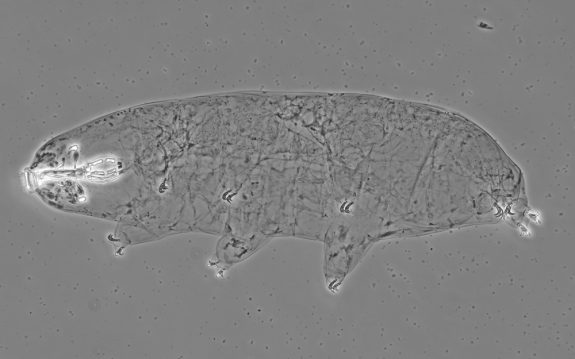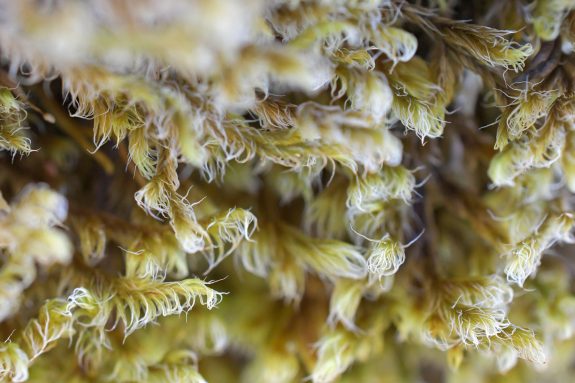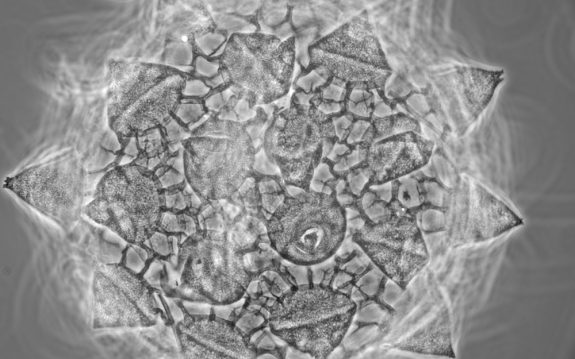New Water Bear Species Found on Calvert Island
Intercontinental collaboration, curiosity, and chance lead to a tardigrade discovery.

Take a walk in a nearby park, on a beach, or even in your backyard, and chances are you’ll unknowingly encounter one—a tardigrade. They’re all around us, those pudgy, eight-legged invertebrates known colloquially as water bears or moss piglets. These aquatic animals are found in a vast variety of habitats, from the Arctic to the Antarctic, from hot springs and sand to the deep sea, and even inside barnacles. Anywhere there’s a thin film of water, there may be tardigrades. You won’t see them—the famously cute and hardy creatures are, at their biggest, barely a millimeter long, still small enough to fit through the eye of a needle. But they’re out there.
The ones along your walk might even be an undescribed, new-to-science species—like the latest biodiversity find near the Hakai Institute’s Calvert Island Ecological Observatory on the Central Coast of British Columbia.
“As soon as I saw the eggs, I knew that it was something new,” says Matteo Vecchi, a tardigradologist (yes, they’re out there, too) at the University of Jyväskylä in Finland.
That “something new” is a tardigrade found by Henry Choong, curator of invertebrate zoology at the Royal BC Museum, in a patch of mosses and liverworts during a 2018 Hakai Institute bioblitz. Now named Sisubiotus hakaiensis—the fifth species given the hakaiensis moniker*—this tardigrade is unique in the most minuscule of ways. “Its eggs are really peculiar. They’re big and have this complex ornamentation,” says Vecchi, who worked with Choong to examine and identify the microscopic animals. The pair recently published their findings in the European Journal of Taxonomy.

The discovery of Sisubiotus hakaiensis was the product of chance connections, collaboration, and scientific intuition. While Choong is not a tardigrade researcher—his specialty is hydroids, relatives of jellyfish—a long-held fascination with the charismatic little water bears, a love of collecting specimens, and an interest in filling in biodiversity knowledge gaps drives him to opportunistically gather moss wherever he goes.
“I’m looking at this rock, and I think, Yeah, I think there’s something there,” says Choong, about the moss-draped rock wall where he gathered the S. hakaiensis samples. “There are certain places that I feel would be good—I can’t explain it.”
While that sense of gestalt paid off, Choong didn’t yet have a plan for his cache of cushiony mosses. “Here I am collecting moss, and I was able to see tardigrades in my samples—but I can’t do very much with them,” he says. Enter Vecchi. “I get an email from Matteo saying ‘I study tardigrades, do you have any moss?’”
Moss is a favorite habitat of both tardigrades and tardigradologists—“usually you find them at the highest densities, and it’s very easy to collect, dry, and ship,” says Vecchi. But the minute moss-dwellers aren’t common enough that you’ll find a tardigrade in every handful. Mere centimeters can yield completely different results.
Even if you do find a tardigrade, Vecchi notes, the animal alone is not enough. “You have to be very lucky to find the right piece of moss with animals and eggs because without the eggs you cannot tell the species.”
But Choong struck tardigrade gold: “The samples [Choong collected] were really rich. I found at least 6 species,” says Vecchi, including the new Hakai tardigrade, complete with the eggs that quickly marked it as novel.

As a newly discovered species within an already uncommon genus—only a few animals belonging to Sisubiotus have been found in North America—there’s still more to learn about S. hakaiensis, but the handful of individuals collected so far can provide some insight. Like most tardigrades, the species is gonochoric, meaning it has both sexes (some tardigrade species have only females and reproduce through parthenogenesis, whereby young develop from unfertilized eggs, while a small number of species are hermaphroditic). At 600 micrometers long—half a grain of sand—S. hakaiensis is on the larger side, and its wide buccal tube, a cheek-like structure used to suck up food, suggests it’s a predator. Some tardigrades graze on algae, bacteria, and even their mossy homes, while others—likely including S. hakaiensis—prey on tinier microscopic invertebrates like rotifers and roundworms, and even other tardigrades.
This is the 59th tardigrade species found in British Columbia, which is home to half the known species in Canada. Globally, only about 1,400 have been described—but the world hasn’t been well sampled for the little water bears, and there’s likely many more yet to be found. Tardigradologists discover new species all the time—Vecchi reckons he finds one every year—and taxonomists have a backlog of new tardigrades to describe. Plus DNA sequencing paired with very fine morphological studies is revealing more about how localized and endemic these charming creatures can be.
With the possibility of a new species in each mossy mound or layer of leaf litter, it’s no wonder Choong continues to collect. But in the end, it’s the collaborative process of curiosity that delights him most about this discovery. “Matteo is working on tardigrades, Hakai sets the stage and environment to encourage this kind of work, and for projects with BC Parks, I’m able to go to different parks and collect data—it all comes together,” he says. “Then to put all of this data into a format that people can use, and have the specimens preserved so we can learn things from them way beyond our current times—that’s the greatest thing to me.”
* The other species bearing the Hakai name run the taxonomic gamut, each in a different phylum: Echinoderes hakaiensis, a microscopic marine invertebrate called a mud dragon; Spiophanes hakaiensis, a marine bristle worm; Bossiella hakaiensis, a red coralline seaweed; and Astrotorhynchus hakaiensis, a flatworm.

